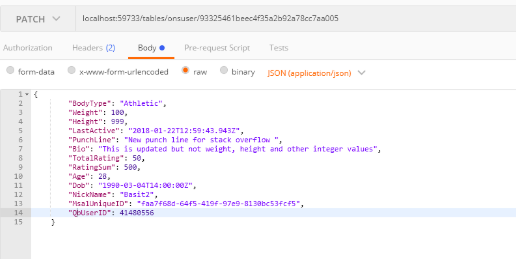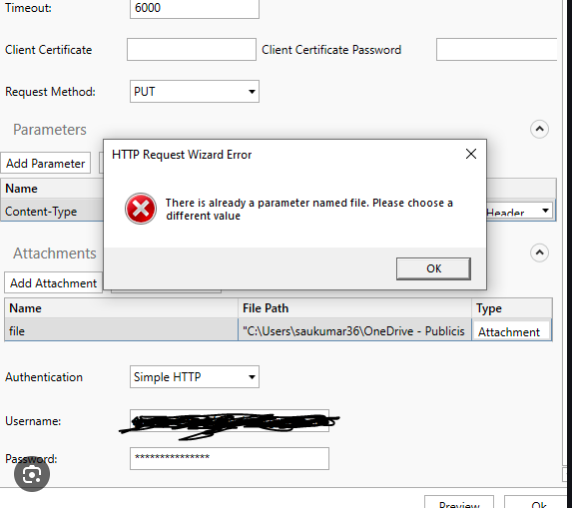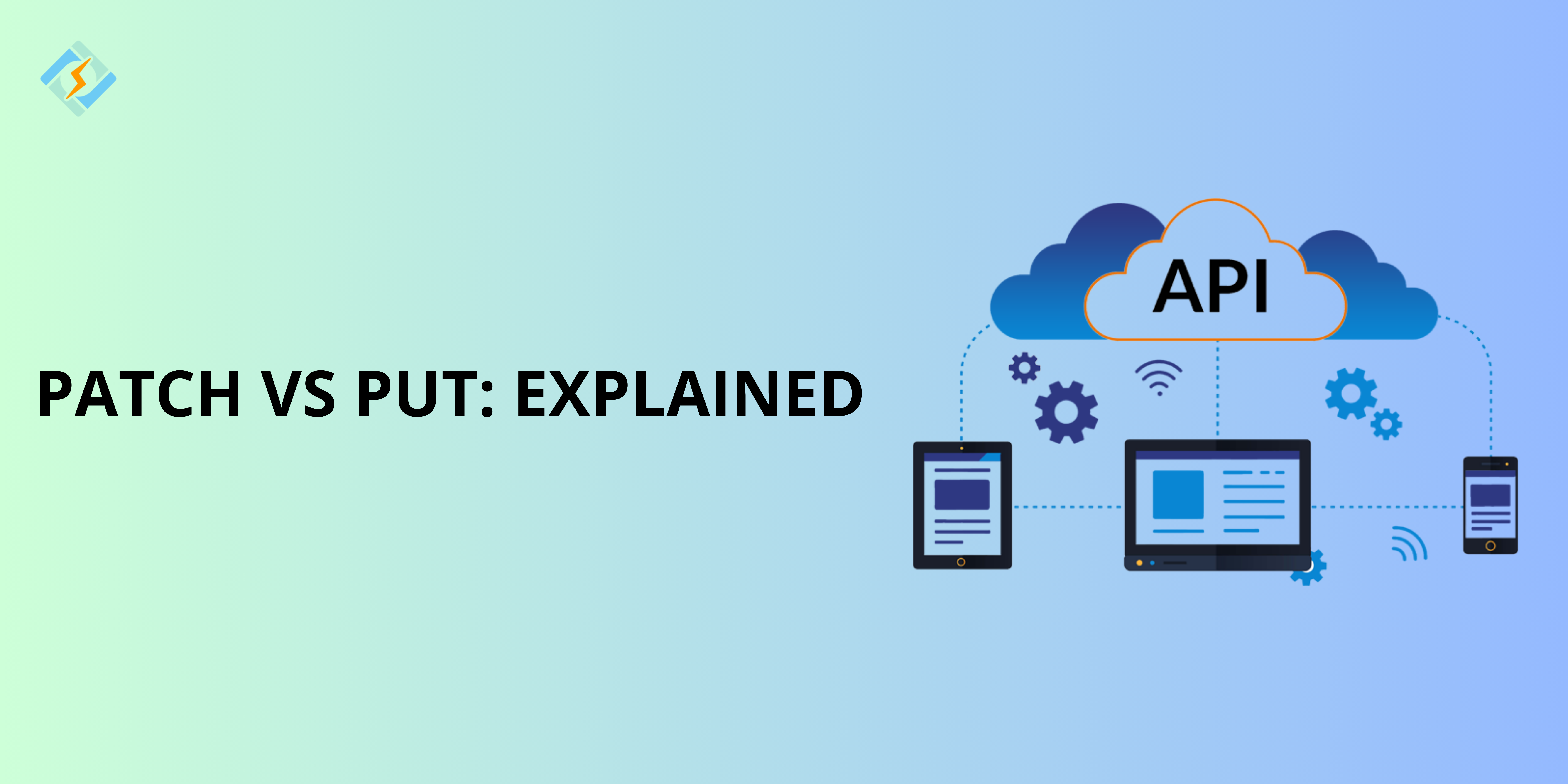Patch vs Put are two reliable HTTP methods for updating resources when working with REST APIs. Both may seem similar but are actually quite different.
Think of a REST API like a digital filing cabinet. When you need to fix a small detail in a document, like correcting a misspelled name, you only change that specific part instead of rewriting the whole document. This is similar to how PATCH works. On the other hand, if you want to replace an outdated document with a completely new version, you should remove the old one and upload the new file. This is how PUT functions.
Let’s understand Patch vs Put differences and see how each offers better performance, or efficient API design in 2025.
What is PATCH?

A PATCH serves as a set of instructions for modifying a resource, It applies modifications to the resource, rather than replacing it entirely.
PATCH is a more practical approach than PUT for making targeted changes since it only alters a specific resource section. It transmits less data and isn’t idempotent, which means that sending the same request multiple times can produce different outcomes. The “body” section contains only the data that needs to be updated, leaving the rest of the resource intact.
PATCH ["?"] HTTP/1.1
Components of the Request-Target and Query
• Uses host header information to identify the destination resource.
• Absolute URL for proxies and absolute route for requests to origin servers.
• An optional query element that comes before? and frequently contains key=value pairs.
Get exclusive access to all things tech-savvy, and be the first to receive
the latest updates directly in your inbox.
Here’s an example to successfully modifying a resource using PATCH:
Assume there is a resource on the server representing a user with a numeric ID of 123 in the following format:
json
{
"firstName": "Example",
"LastName": "User",
"userId": 123,
"signupDate": "2024-09-09T21:48:58Z",
"status": "active",
"registeredDevice": {
"id": 1,
"name": "personal",
"manufacturer": {
"name": "Hardware corp"
}
}
}
Instead of sending a JSON object to fully overwrite a resource, a PATCH modifies only specific parts of the resource. This request updates the status field:
http
PATCH /users/123 HTTP/1.1
Host: example.com
Content-Type: application/json
Content-Length: 27
Authorization: Bearer ABC123
{
"status": "suspended"
}
The interpretation and authentication of the request depend on the specific implementation. Success can be indicated by any of the successful response status codes. In this example, a response is used because there is no need to transmit a body with additional context about the operation.
http
HTTP/1.1 204 No Content
Content-Location: /users/123
ETag: "e0023aa4f"
What is PUT?

It is used to fully update an entity’s information. PUT is similar to POST but will replace the entity if it already exists or create a new one if it doesn’t. You can use a PUT request to add a user to your database, even if that user is already there.
It replaces the current resource with a new version. Here’s an example of how it creates a new resource:
This PUT request aims to create a resource at example.com/new.html with the content

New File:
http<br>PUT /new.html HTTP/1.1<br>Host: example.com<br>Content-type: text/html<br>Content-length: 16New File
If the resource does not currently exist and the PUT request is successful, the server should respond with a 201 Created status:
http<br>HTTP/1.1 201 Created<br>Content-Location: /new.htmlIf the resource already exists and is successfully updated, the server must respond with either a 200 OK or a 204 No Content to confirm the request was completed:
http<br>HTTP/1.1 204 No Content<br>Content-Location: /existing.htmlPATCH vs PUT: Key Differences
Now comes the main part, how are the aspects that differentiate PATCH vs PUT? Let’s find out!
1. Idempotency: How Each Method Behaves
PUT is idempotent, while PATCH is not. Meaning that making multiple identical PUT vs patch requests should have the same effect as a single request.
PATCH vs PUT is designed to be idempotent, although its implementation may differ. In reality, it is advisable to carry out HTTP PATCH vs PUT requests in an idempotent way to maintain consistent results.
2. Partial Updates vs Full Updates
PATCH vs PUT performs a partial update. It modifies only the fields specified in the request, leaving the rest of the resource unchanged.
PUT vs PATCH, on the other hand, replaces the entire resource. If any field is missing from the request body, it may lead to the deletion of those fields in the resource being replaced.
Example:
Consider a user object that includes name, email, and age:
A PATCH request that includes only the email will update just that field.
A PUT request with only the email will replace the entire object, potentially removing the name and age.
3. Efficiency
PATCH vs PUT is more efficient as it only sends the data that needs to be updated, making it ideal for large objects or situations with limited bandwidth.
PUT vs PATCH is less efficient because it sends the entire resource even for small updates, leading to higher bandwidth usage.
4. Risk of Data Loss
Using PUT, if a field is left out of the request, it may be deleted from the resulting resource.
In contrast, PATCH does not pose this risk since it only updates the specified fields and leaves others unchanged.
5. Complexity
PATCH vs PUT is slightly more complex for the server to process because it must integrate the new data with the existing resource.
PUT vs PATCH is simpler in terms of logic, as it completely overwrites the resource.
When Should You Use HTTP PATCH vs PUT?
Now that you understand the distinctions between PUT vs PATCH, it’s important to know when to use each method to ensure your API functions correctly.
Use HTTP PUT vs PATCH requests in these situations:
- When you need to completely replace a resource’s content. A PUT vs Patch request must include data for every field; otherwise, missing fields may revert to default values or be removed.
- In cases that require idempotency, meaning the request should yield the same outcome no matter how many times it is sent.
- When creating a new resource, PUT can be a better choice than POST if the client already knows the resource’s identifier or location. It is also preferable when idempotency is necessary.
On the other hand, PATCH vs PUT requests are suitable for:
- Making partial updates. PATCH modifies only specific fields of a resource as specified in the request, allowing for more efficient API management and reducing the risk of unintended changes.
- Frequent updates and situations that demand efficiency. Since only the necessary data is sent and changed, updates can be handled smoothly, whether they occur often or not.
- Managing complex resources with large amounts of data. PATCH vs PUT minimizes the risk of accidentally deleting information by only altering the fields mentioned in the request.
SEO Impact: PATCH vs PUT in Web Development
PATCH and PUT HTTP Methods and Their Impact on SEO
- The PATCH and PUT HTTP methods influence website structure, content, and user experience, which can affect search engine rankings.
- PATCH makes incremental updates, while PUT replaces the entire resource.
- SEO implications involve keyword relevance, meta descriptions, and on-page factors.
- Improperly executed updates can harm user experience and lead to penalties from search engines.
- Managing PATCH and PUT can affect technical SEO aspects like page speed and crawlability.
Key SEO Considerations:
- Updates should enhance keyword relevance.
- Meta descriptions need to be revised to align with new content.
- URL structures should be adjusted to prevent broken links and preserve SEO value.
- User experience factors, such as page load speed, site layout, and mobile compatibility, must be prioritized.
- Technical SEO should ensure crawlability is intact, sitemaps are updated, and canonical tags are used.
Examples:
{
“PATCH: Updates specific parts of a blog post while keeping the rest unchanged.”
- PUT: Completely replace the existing blog post with a new version.
- SEO effects: PATCH vs PUT can enhance SEO ranking if the new content improves user experience.
Final Thoughts
Deciding whether to use PATCH vs PUT actually comes down to how much data you want to update and how complex the resources are. Understanding when to use each method ensures that an API’s resources are utilized more effectively, which ultimately enhances the user experience.
FAQ’s
1. Is PATCH vs PUT the better choice for updating data?
It really depends on your needs. Go with PATCH for making partial updates and choose PUT when you want to replace everything.
2. Does PATCH replace the whole resource?
Not at all, PATCH only modifies the fields you specify.
3. Why is PUT vs PATCH seen as idempotent?
Because if you send the same PUT request multiple times, the resource will remain in the same state each time.
4. What are the consequences of misusing PATCH or PUT?
If you use PATCH when you should have used PUT, you might end up with incomplete updates. On the other hand, using HTTP PUT vs PATCH when it’s not necessary can lead to data loss and increased bandwidth consumption.



